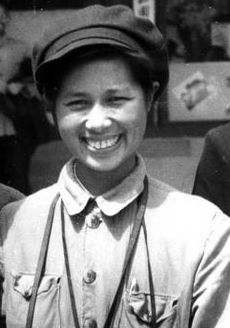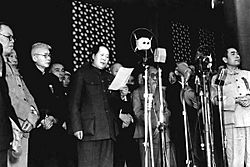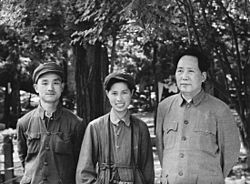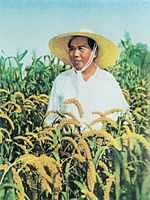Hou Bo facts for kids
Quick facts for kids
Hou Bo
|
|
|---|---|
 |
|
| Born | September 17, 1924 Xia County, Shanxi Province, Republic of China
|
| Died | November 26, 2017 (aged 93) Beijing, China
|
| Occupation | Photographer |
| Political party | Communist |
| Spouse(s) |
Xu Xiaobing
(m. 1943; died 2009) |
| Children | 2 |
Hou Bo (Chinese: 侯波; 17 September 1924 – 26 November 2017) was a famous Chinese photographer. With her husband Xu Xiaobing, she took many well-known photos of Mao Zedong, a very important leader in China.
Hou Bo grew up in a poor family. She joined the Communist Party when she was 14 years old. She learned photography during the Second Sino-Japanese War. Her goal was to show the world the good work of the Party. After 1949, she and her husband lived near Mao Zedong. They took both official photos for posters and publicity, and also informal family pictures.
Some of her most famous photos include "The Founding of the PRC" (1949) and "Mao Zedong Swimming Across the Yangzi" (1955). She also took "Chairman Mao at Work in an Airplane" (1959) and "Mao Zedong with Students from Latin America" (1959). The last one won a top prize at a photography exhibition in 1959.
Contents
Early Life and Learning Photography
Hou Bo was born in September 1924 in Xia County, Shanxi Province. Her family was very poor. She joined the Chinese Communist Party when she was 14.
She met her future husband, Xu Xiaobing, in 1942. He was a photographer for the army. He taught her about photography. They got married in 1943. Hou Bo remembered their wedding as a simple gathering with friends. They ate dried buns and sang songs.
Work often kept Hou Bo and Xu Xiaobing apart. But Hou kept learning photography from Japanese prisoners. In 1949, she and Xu were reunited. Mao Zedong noticed Hou Bo and asked her to join his team of official photographers.
One of Hou Bo's most famous photos is of Mao Zedong on October 1, 1949. This was the day the People's Republic of China was founded. This picture is one of the most widely seen photos from modern times. She also took many less formal pictures of the leaders. She later said she felt very excited when she took the photo of Chairman Mao declaring the new nation.
Working as an Official Photographer
From 1950 to 1961, Hou Bo lived in Zhongnanhai. This was where top Party officials lived. She started the Photography Department there. Her husband and two children also lived there. Mao's children even called her "Aunt Hou Bo."
Hou Bo took many photos of Mao Zedong. She took over 400 of the 700 official photos published during this time. She and Xu Xiaobing became very important photographers. They took formal pictures of Mao that became famous posters. They also took relaxed photos of him with his family.
Her job was to photograph not only Mao, but also other important leaders. These included Zhou Enlai, Zhu De, and Liu Shaoqi. She traveled with these officials. She often captured them in natural moments. For example, her photo "Chairman Mao at Work on an Aeroplane" (1957) shows him focused on reading. These personal photos were not shared with the public. They were kept for official records.
Hou Bo was transferred from Zhongnanhai in 1961. When she left, Mao told her that she had taken "a lot of very good pictures" of him over 12 years.
Later Life and Recognition
In their later years, Hou Bo and her husband became known outside China too. A documentary film was made about them in 2003. Their photos of Mao were also shown in an exhibition in London in 2004.
After her husband passed away in 2009, Hou Bo said she was still a communist. She admired Mao Zedong's work. She felt that she and her husband were "ordinary workers" who helped build a new China. She believed Mao made a big contribution to make China a great country. Hou Bo passed away on November 26, 2017, at the age of 93.
Her Legacy in Photography
One of Hou Bo's photos shows Mao in a rice field. This picture became a very popular poster. It shows how comfortable Hou Bo was in China's rural areas. The critic Claude Hudelot said the photo makes Mao look like an "Emperor of Nature." This poster was printed millions of times in 1958.
The photographer Zhang Zhaotang from Taiwan praised Hou Bo's work. He said that even as an official photographer, she managed to take natural and lively pictures. He noted her hard work and dedication.
See also
 In Spanish: Hou Bo para niños
In Spanish: Hou Bo para niños
Images for kids







